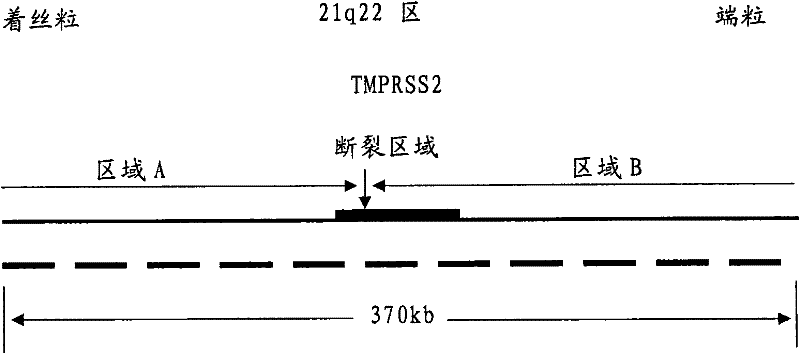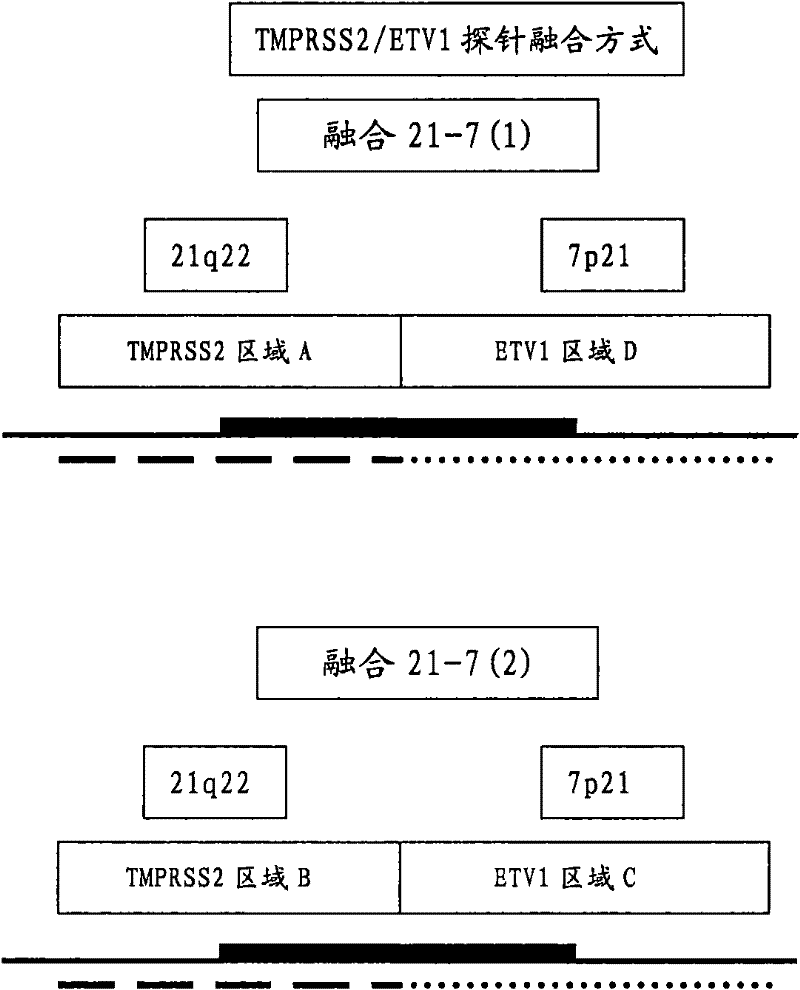Detection agent for detecting prostate cancer and application thereof
A prostate cancer, detection agent technology, applied in the direction of microbial determination/inspection, fluorescence/phosphorescence, biochemical equipment and methods, etc., can solve the problems of inability to effectively distinguish prostate hyperplasia, low diagnostic value, missed diagnosis, etc., and achieve naked eye detection. Significant effect, good for observation, large coverage effect
- Summary
- Abstract
- Description
- Claims
- Application Information
AI Technical Summary
Problems solved by technology
Method used
Image
Examples
Embodiment 1
[0147] The preparation of embodiment 1GLP TMPRSS2 / ETV1 probe set
[0148] The TMPRSS2 probe was prepared using the random priming method, and the template DNA was labeled as fluorescent red (Tetramthylrhodamine-5-dUTP, purchased from Roche). The probe preparation kit was purchased from Roche (Random Primed DNA Labeling Kit)
[0149] 1. Template DNA preparation (take RP11-814F13 as an example):
[0150] (1) Take an appropriate amount of purchased clone RP11-814F13 (existing in the form of bacterial liquid) for amplification culture;
[0151] (2) Pick a single colony grown on LB solid medium, inoculate it in 20ml LB (containing Amp100μg / ml) liquid medium, culture at 37°C and shake at 250rmp overnight (about 12-14 hours);
[0152] (3) Pour 1.5ml of the culture solution into a 1.5ml eppendorf tube and centrifuge at 12000rmp for 1-2 minutes. Discard the supernatant, and place the centrifuge tube upside down on toilet paper for a few minutes to drain the liquid as much as possible...
Embodiment 2
[0187] The preparation of embodiment 2GLP ERG probe group
[0188] The preparation process of the GLP ERG probe set is the same as the preparation of the GLP TMPRSS2 / ETV1 probe set in Example 1, except that the selected clones are different (the clones specifically used in this example are: RP11-476D17, CTD-2341O18, RP11 -95I21, and RP11-259A4), both include several steps of DNA preparation, probe mixture preparation, probe labeling, mixing, and purification.
Embodiment 3
[0189] The preparation of embodiment 3GLP TMPRSS2 / ETV4 probe group
[0190]The preparation process of the GLP TMPRSS2 / ETV4 probe set is the same as the preparation of the GLPTMPRSS2 / ETV1 probe set in Example 1, except that the selected clones are different (the clones specifically used in this example are: RP11-671L10, AL773578, CTD- 2337B13, CTD-3095D11, CTD-2326M16, CTD-3215I16, and CTC-420I11), all include several steps of DNA preparation, probe mixture preparation, probe labeling, mixing, and purification.
PUM
 Login to View More
Login to View More Abstract
Description
Claims
Application Information
 Login to View More
Login to View More - Generate Ideas
- Intellectual Property
- Life Sciences
- Materials
- Tech Scout
- Unparalleled Data Quality
- Higher Quality Content
- 60% Fewer Hallucinations
Browse by: Latest US Patents, China's latest patents, Technical Efficacy Thesaurus, Application Domain, Technology Topic, Popular Technical Reports.
© 2025 PatSnap. All rights reserved.Legal|Privacy policy|Modern Slavery Act Transparency Statement|Sitemap|About US| Contact US: help@patsnap.com



